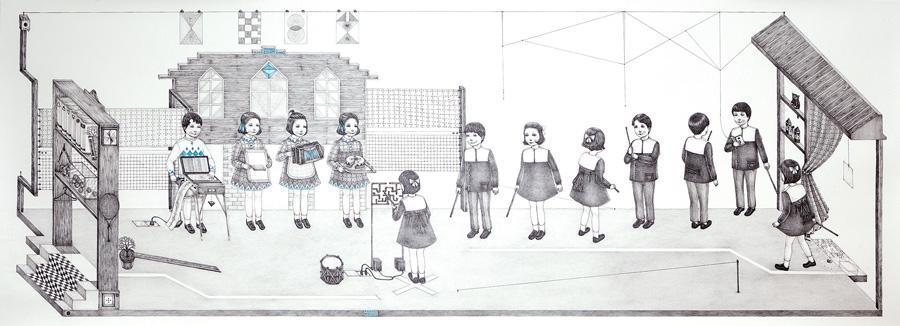Exhibit explores societal limits on life
Hatice Utkan Özden

A joint exhibition at Istanbul art gallery Adas brings together various artists in an exhibition that examines the impact of social and political control and pressure on human psychology.
Curated by Melike Bayık, the exhibition, titled “Standard,” features artists İhsan Oturmak, Yuşa Yalçıntaş, Işıl Eğrikavuk & Jozef Erçevik Amado, Merve Dündar, Erinç Seymen, Leyla Emadi, Nasan Tur, Zafer Akşit, Özlem Günyol and Mustafa Kunt, Yasemin Özcan and Ferhat Özgür, among others.
Bayık takes her inspiration from French philosopher Michel Foucault’s “discipline concept.”
“What I am trying to show is how we face restraints and pressure in society and how these feelings shape us in the end,” Bayık said.
Each artwork in the exhibition is an interpretation of how people are destined to be part of the society they are living in but still how there is hope to raise a new way of seeing things in society.
“What I have tried to do is to show society and we (as humans) are destined to be part of each other. But this creates a real challenge. So the question remains the same: Are we all shaped by the society we are living in?” Bayık said.
To emphasize the importance of this question, Bayık takes on Michel Foucault’s legendary text titled “Disciplinary Society.”
“In this text, Foucault’s picture of modern disciplinary society is separated into different parts such as hierarchical observation, normalizing judgment and the examination. In short, we can say Foucault questions control over people [power] and how this power is only achievable via observing them,” Bayık said.
The exhibition opens with Foucault’s sentence on observing people, and as the viewer wanders through the exhibition starting from Yalçıntaş and Oturmak’s works.
“These works are significant for the theme of the exhibition as they focus on the aspect of school life and how we become a part of the school’s disciplinary nature, and I believe this is our first step to a disciplinary society,” the curator said.
While artwork suggests we become suppressed beings with pressure from society, Bayık, on the other hand, said she wanted to show there is still hope of freeing ourselves in society.
“Özcan’s photography work shows this aspect very well. The photo work depicts that each time we leave things, let them be; a new hope comes along. The story of the work begins when the artist leaves town for a few weeks. When she comes back, she sees a small plant coming out of the bathroom tub,” Bayık said.
The show spans two different floors. On the upper floor, more political works take the scene. Özgür’s video work, “I Love You 301,” takes on the democracy problems in Turkey. Meanwhile, Tur’s work looks at politics within its linguistic nature. Tur depicts the language that politicians use during their public speeches and how they pronounce words in Turkish. We see wrongly pronounced words in neon.
All of the works together create a whole language on how we are destined to live a limited life within society and maybe never be our true selves in this environment.
As the viewer takes the stairs to the upper floor, Emadi’s work, “I have no borders,” salutes the viewer. This work is a significant one as it makes the viewer question herself. Do we have to have borders, or is it possible to overcome all the borders in the society?
The exhibition is on display at the gallery in the European district of Kağıthane through May 31.
















